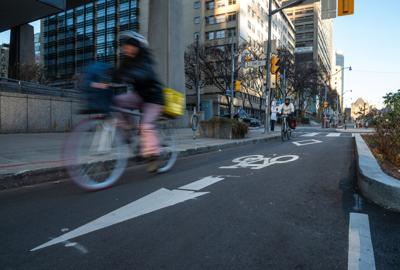Premier Doug Ford is gearing up to remove even more º£½ÇÉçÇø¹ÙÍøbike lanes, the Star has learned.
Sources say Thursday’s provincial budget legislation will include the removal of the bike lanes on Queen’s Park Crescent, around the legislative precinct, and on Avenue Road south of Davenport Road.
That’s on top of the bikeways slated for demolition on University Avenue, Yonge Street and Bloor Street West.
A temporary court injunction obtained by cycling advocacy groupsÌý— and being contested by Ford’s governmentÌý— has halted the removal of those three lanes while a judge determines whether the scheme is unconstitutional.
“I’m not against bike lanes. I just want to get these things moving ... build all the bike lanes you want just not on main arterial roads, put them on the side roads. Let’s ... get traffic moving,” the premier said Wednesday.
The province’s effort to remove bike lanes in downtown º£½ÇÉçÇø¹ÙÍøwas put on pause after a Superior
Senior government officials, speaking confidentially in order to discuss internal deliberations, said the budget will signal the Progressive Conservatives remain committed to moving bike lanes off major thoroughfares to tackle traffic gridlock.
Finance Minister Peter Bethlenfalvy will table the spending plan at 4 p.m. Thursday.
The move comes afterÌýJustice Paul Schabas granted an injunction on April 22 temporarily pausing the dismantling of bike lanes pending his decision on a Charter challenge by advocates, including Cycle Toronto.
The pause on any bike lane removals will continue until the judge in the Charter challenge case
Cycling activists argue Ford is infringing upon their Charter rights to life and security of person.
Michael Longfield, executive director of Cycle Toronto, has warned the changes would do little to reduce traffic but could imperil cyclists.
“We think the (legal) case itself is really strong and it’s underpinned by the idea that the removal of these bikeways is arbitrary and doesn’t meet the province’s goal of reducing congestion,” Longfield said last week.
The Star revealed last November that the exhaustive $6.2 million Transportation Tomorrow Survey found only 3.1 per cent of º£½ÇÉçÇø¹ÙÍøresidents bike to work each morning.
That number jumped to 3.6 per cent of those who reported using their bikes “all day” in a city of three million people where 164,806 daily cycling trips were made, an uptick from the same survey in 2006 that foundÌý1.1 per cent of Torontonians reported such trips.Ìý
However, city-wide biking data can be contentious as usage fluctuates depending on where people live — which the cycling lobby, that wields influence at city hall with bureaucrats and elected officials, is quick to point out.Ìý
Mayor Olivia Chow has expressed hope for a “win-win solution” that could preserve some bikeways while reinstating lanes for car traffic to appease Ford.
“There are areas that we may be able to do so, so the conversation is ongoing,” Chow, long one of the city’s most prominent cyclists, said last week while discuss Toronto’s congestion management plan.
But she declined to say what sections are being discussed with Queen’s Park, stressing she is “firm” on keeping the long-established bike lanes on Bloor Street West in the Annex.
Chow has noted local businesses and residents support those lanesÌý— installed under mayor John Tory in 2016Ìý— “so there’s no reason to rip up the road and cause more congestion and waste a lot more money.”
That said, she’s admitted there are newer bikeways “that we might be able to improve on.”
Last November, Ford’s Tories passed legislation curbing the installation of bike lanes and empowering Queen’s Park to remove existing ones on Bloor, Yonge and University.
But because University ends at College Street, the bill did not specifically include Queen’s Park Crescent, which begins there and continues to Bloor where it becomes Avenue Road.
That’s what Thursday’s budget law will clarify, sources said.
Bike lanes on College are not included in the bill and insiders say there are no plans to remove them.
To protect its legal flank, the government has indemnified itselfÌýagainst any lawsuits if someone is killed or injured where a lane has been removed.
The province was slated to begin ripping out the most contentious section of the Bloor lanesÌý— west of Runnymede RoadÌý— in March but the work had not begun before Schabas’s injunction.
City hall has estimated it would cost $48 million to dismantle 22 kilometres of bike lanes that cost $27 million to install, a claim Ford has dismissed as inflated “hogwash.”
That outburst earned Ford from Chief Justice of Ontario Michael Tulloch,ÌýChief Justice of the Superior Court of JusticeÌýGeoffrey Morawetz, and Chief Justice of the Ontario Court of Justice Sharon Nicklas.
Citing the importance of judicial independence, the three chief justices said judges “must be, and must be seen to be, free to decide each case on its own merits, without interference or influence of any kind from any source, including politicians.”
Prior to being appointed a judge by former federal justice minister David Lametti in 2019, Schabas was a partner at Blakes and one of the Star’s lawyers for many years.
Error! Sorry, there was an error processing your request.
There was a problem with the recaptcha. Please try again.
You may unsubscribe at any time. By signing up, you agree to our and . This site is protected by reCAPTCHA and the Google and apply.
Want more of the latest from us? Sign up for more at our newsletter page.































To join the conversation set a first and last name in your user profile.
Sign in or register for free to join the Conversation